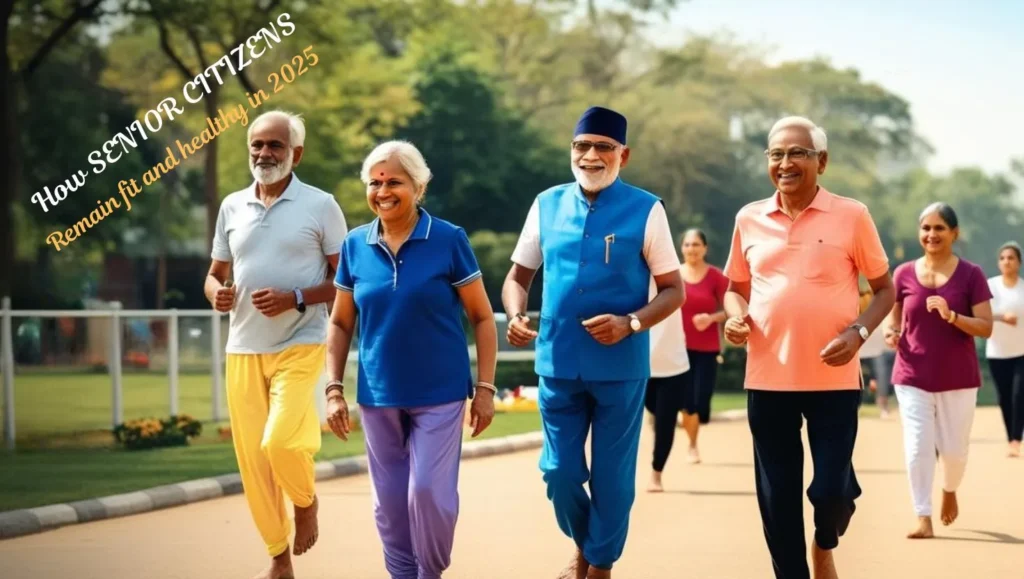Table of Contents
ToggleSenior Citizens Hack to Remain Fit and Healthy
A healthy body can support a healthy brain, and vice versa. You can keep your brain active by maintaining a healthy lifestyle. Aging gracefully is an art that combines the right balance of physical fitness, a nutritious diet, mental stimulation, and social connections. In 2025, advancements in technology, greater awareness of health, and evolving lifestyles have made it easier than ever for seniors to live vibrant, fulfilling lives. Here’s an in-depth guide on how to remain fit and fine after 60 by focusing on diet, fitness, activities, and social outreach.
1. Fitness After 60: Staying Physically Active
Staying active is the foundation of a healthy lifestyle after 60. The key is to focus on low-impact, sustainable exercises that improve strength, flexibility, balance, and endurance.
1.1. Types of Exercises for Seniors
- Flexibility and Balance
- Yoga: Enhances flexibility, balance, and mental calmness. Choose beginner-level classes or online tutorials.
- Tai Chi: A slow, meditative practice that promotes balance and reduces the risk of falls.
- Cardio Workouts
- Walking: A brisk 30-minute walk daily can improve cardiovascular health and boost energy levels.
- Swimming: Gentle on the joints and excellent for improving stamina and lung capacity.
- Cycling: Low-impact, enjoyable, and great for heart health. Electric bikes can also be a great option.
- Strength Training
- Use resistance bands or light weights for exercises like bicep curls, squats, and wall push-ups to combat muscle loss and strengthen bones.
- Aim for two sessions a week to maintain muscle mass.
1.2. Fitness Technology for Seniors in 2025
- Invest in wearable fitness trackers like Fitbit or Apple Watch to monitor your steps, heart rate, and sleep.
- Use fitness apps tailored for seniors, such as SilverSneakers GO or Aaptiv, for guided workouts.
- Consider virtual reality (VR) exercise programs that make fitness fun and interactive.

2. Nutrition for Seniors: Eating for Energy and Longevity
A nutritious diet becomes even more critical after 60 to maintain energy levels, strengthen immunity, and prevent chronic illnesses like diabetes and heart disease.
2.1. The Ideal Senior Diet
- High-Fiber Foods: Prevent constipation and improve gut health. Include oats, whole grains, fruits like apples, and vegetables like broccoli.
- Lean Proteins: Essential for muscle repair and maintenance. Incorporate eggs, fish, chicken, tofu, and lentils.
- Omega-3 Fatty Acids: Improve brain health and reduce inflammation. Sources include salmon, walnuts, and flaxseeds.
- Calcium and Vitamin D: Strengthen bones and prevent osteoporosis. Add dairy products, fortified cereals, and leafy greens to your meals.
- Antioxidants: Combat aging by reducing oxidative stress. Include berries, dark chocolate (in moderation), and green tea.
2.2. Personalized Nutrition Trends in 2025
- DNA-Based Diets: Use personalized nutrition services like Nutrigenomics, which tailor diet plans to your genetic makeup.
- Sustainable Superfoods: Try trendy superfoods like spirulina, moringa, or plant-based protein powders.
- Smart Kitchen Gadgets: Use AI-powered devices to track nutrient intake and suggest recipes based on your health goals.
2.3. Meal Tips for Seniors
- Eat smaller, frequent meals to maintain energy levels throughout the day.
- Stay hydrated—drink at least 8 glasses of water daily and include hydrating foods like cucumber and watermelon.
- Reduce sodium and sugar intake to manage blood pressure and diabetes.
3. Activities for Mental and Emotional Wellness
Engaging in activities that challenge your mind and bring joy is crucial for mental health.
3.1. Cognitive Exercises
- Solve puzzles, Sudoku, or crossword games to keep your mind sharp.
- Learn new skills like painting, cooking, or playing a musical instrument.
- Take online courses or join community workshops to stimulate your brain.
3.2. Mindfulness Practices
- Practice meditation or deep breathing exercises to reduce stress and improve focus.
- Maintain a gratitude journal to foster a positive mindset.
3.3. Hobbies and Leisure
- Gardening: Boosts mood and provides light physical activity.
- Reading: Join book clubs or download audiobooks for intellectual stimulation.
- Travel: Plan trips to senior-friendly destinations to explore new places and cultures.
4. Social Outreach: Building a Vibrant Community
Isolation can affect mental health, so it’s essential to stay socially active.
4.1. Building Connections
- Join local clubs or senior centers to meet like-minded individuals.
- Participate in volunteer programs, such as teaching kids, community gardening, or helping at animal shelters.
- Use social media platforms like Facebook to connect with family and friends.
4.2. Online Communities
- Explore online forums or groups for seniors where you can share experiences, hobbies, and tips.
- Join virtual fitness classes or hobby groups to stay engaged.
4.3. Intergenerational Bonding
- Spend quality time with grandchildren, teaching them about your life experiences or learning modern technology from them.
- Host family dinners or game nights to strengthen family bonds.
5. Combining Diet, Fitness, and Social Life: A Holistic Approach
The secret to staying fit and healthy after 60 lies in balancing all aspects of well-being. A typical day could look like this:
- Start your morning with 10 minutes of yoga followed by a nutritious breakfast of oatmeal topped with fruits and nuts.
- Take a 30-minute walk with a neighbor or listen to a podcast while walking alone.
- Spend the afternoon gardening, volunteering, or attending a hobby class.
- End the day with a healthy dinner and a phone or video call with loved ones.
Conclusion
Remaining fit and healthy after 60 in 2025 is no longer a challenge with the right combination of diet, fitness, engaging activities, and social outreach. By embracing modern tools and adopting proactive habits, you can enjoy a vibrant and fulfilling life well into your golden years. Age is just a number—take charge of your health and make every year your best yet!
